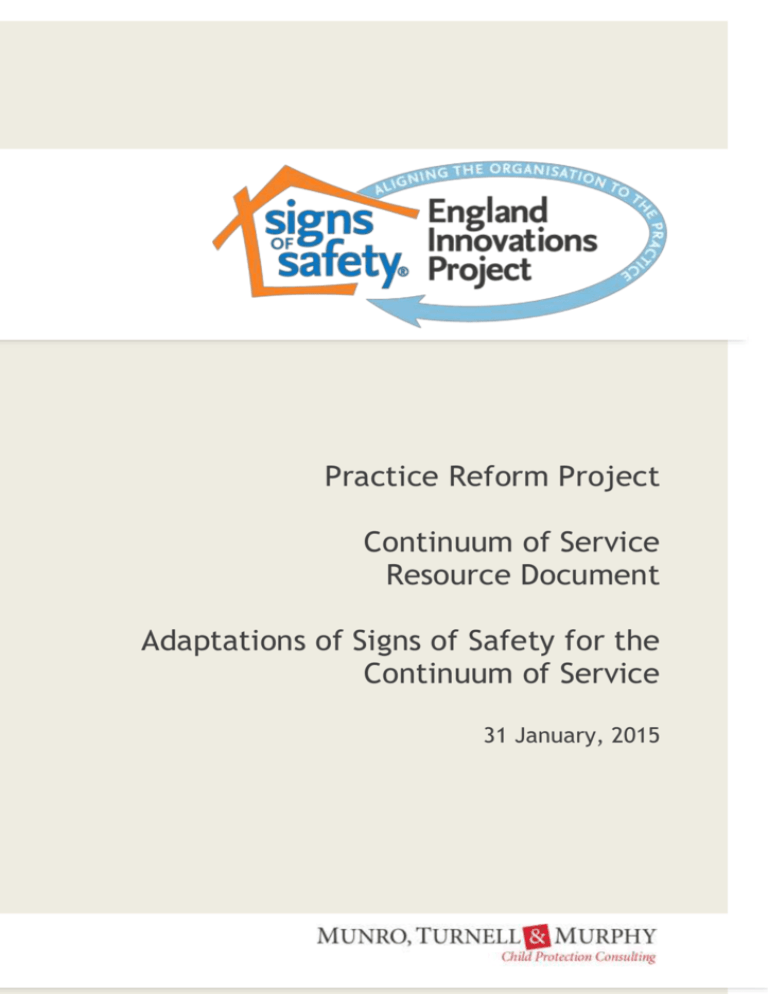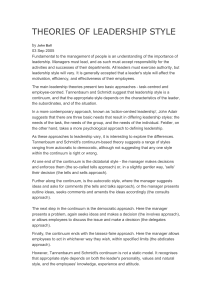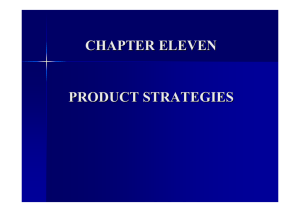adaptations of signs of safety for the continuum of service
advertisement

Practice Reform Project Continuum of Service Resource Document Adaptations of Signs of Safety for the Continuum of Service 31 January, 2015 ADAPTATIONS OF SIGNS OF SAFETY FOR THE CONTINUUM OF SERVICE This paper charts the key aspects of the Signs of Safety approach that are applied unchanged and those that are adapted across the continuum of service, with examples to illustrate. The simplified continuum of service encompasses: Early help Children in need Child protection Looked after children Youth at risk Young offenders ASSESSMENT AND PLANNING FRAMEWORK The key changes apply to the three column assessment and planning framework. The framework below shows the four domains of enquiry and seven analysis categories and those domains and categories that stay the same across the continuum of service: When we think about the situation facing this family: What are we worried about? Harm What is working well? What needs to happen? Existing strengths Safety goals Existing safety Next steps Danger statement Complicating factors On a scale of 0 to 10 where 10 is everyone knows the children are safe enough for child protection authorities to close the case and zero means things are so bad for the children they can’t live at home, where do we rate this situation? (if different numbers place different people on the continuum) 0−−−−−−−−−−−−−−−−−−−−−−−−−−−−−−−−−−−−−−−−−−−−−−−− 10 Examples of Adaptations to the Analysis Categories: Harm Danger Existing safety Safety goals Risky behavior Worry statement Positive relationships Goals Critical risk Positive developments Good things Critical worry Concern Risks Main worry Disconnections Worst case scenario Getting worse Happy things When it was different When it worked Connections Wellbeing goals Success goals Stability goals Achievement goals Motivations Dreams Changes Stuff that’s gotta change Examples of Adaptations to the Scaling Question: Mess to success - On a scale of 0 to 10, where 10 means my life is ‘on track’ to where you want to go in life and 0 is my life’s a complete mess, where are you? Placement stability – On a scale of 0 to 10 where 0 is things have got so bad, there is so much conflict, anxiety and mistrust that …. (the foster child) has to leave the placement now, and 10 is we have all understood what has happened and wht we need to do so we can live and work together into the future happily and are totally up for doing it, where are you? And where is…? Confidence about not getting into trouble with the law - On a scale of 0 to 10 where 10 is everyone is confident that the young person won’t get into any more problems with the law / justice system and 0 means you think the young person will be back in trouble and in court immediately, where are you? And where is…? How Many of the Parts of the Assessment and Planning Framework to Use? Practitioners and partners will vary as to how many parts of the assessment and planning framework will be used in different cases and circumstances. The three columns alone may guide some discussions with partners and referrals. All four domains of enquiry, the three columns and scaling questions, will be used in all formal assessment and planning across the continuum. As assessment and planning and case management proceed, the analysis categories will come into play. It may be that a ‘worry statement’ and ‘goals’ are enough to plan the case. The more complex the case, the more analysis categories will come into play. Child Protection cases use all the domains of enquiry and categories of analysis. THE NAME – “SIGNS OF …. ” With the various adaptations, the name Signs of Safety itself, when working with families and young people, can be adapted. Signs of Safety Signs of Success Signs of Wellbeing Signs of Stability Signs of Achievement Signs of Motivation PRINCIPLES All the principles apply: Working relationships Stance of critical enquiry Being grounded in everyday practice DISCIPLINES The following disciplines apply unchanged: Plain language Statements focusing on specific observable behaviors Skillful use of authority Assessment is always a work in progress The disciplines that distinguish between harm and danger and complicating factors, and between strengths and protection, are adapted: Being clear about the critical things that have actually occurred, what the workers are worried could occur if there is no change in behavior and other circumstances. Being clear about the positive things in general and those actual behaviors that have demonstrated a capacity to overcome the main worries. OTHER SIGNS OF SAFETY TOOLS Three houses, and also the fairy and wizard variation, apply across the continuum. Word and pictures explanations and plans can apply across the continuum. OTHER KEY ASPECTS OF SIGNS OF SAFETY Questioning approach is central across the continuum. Networks of family and friends and community supports apply across the continuum. . SIGNS OF SAFETY LEARNING All staff should be trained in the full Signs of Safety to show the thinking, the application to the most difficult cases, and because cases step up and down. Training should introduce the way Signs of Safety is adapted across the continuum and let workers know that it is OK to adapt the framework and be flexible in how it is used. Practice leaders can continue this learning with teams. Appreciative enquiry, with families, young people and practitioners describing good practice and what made it so, is powerful for learning and development, across the continuum



